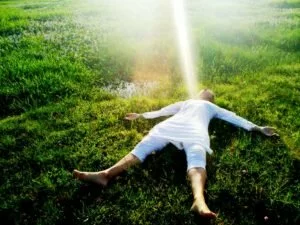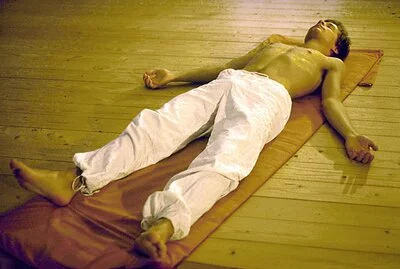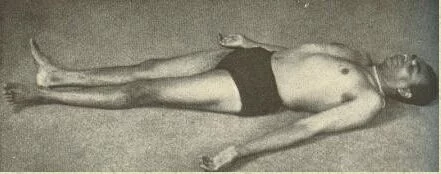 Savasana (shah-vah-sah-nah; Sanskrit: शवासन; IAST: śavāsana), or Corpse Pose is an asana.
Savasana (shah-vah-sah-nah; Sanskrit: शवासन; IAST: śavāsana), or Corpse Pose is an asana.
The name comes from the Sanskrit words Shava (शव, Śava) meaning “corpse” and Asana (आसन, Āsana) meaning “posture” or “seat”.
Description:-
Shavasana or mrtasana (death pose)
Shavasana is perhaps the most important part of yoga practice. Lying on the back, the arms and legs are spread at about 45 degrees, the eyes are closed and the breath deep, using deergha (long) pranayama. The whole body is relaxed onto the floor with an awareness of the chest and abdomen rising and falling with each breath. All parts of the body are scanned for muscular tension of any kind, which is consciously released as it is found, optionally with a small repetitive movement of the area. All control of the breath, the mind, and the body is then released for the duration of the asana, typically 20–30 minutes although often less in Western yoga classes.
The asana is released by slowly deepening the breath, flexing the fingers and toes, reaching the arms above the head, stretching the whole body, exhaling, bringing the knees to the chest and rolling over to the side in a fetal position. After a short time and a slow inhalation, the practitioner takes a seated position.
Benefits:-
It is intended to rejuvenate body, mind, and spirit.
Relaxation:-
After the exertions of the practice, Shavasana allows the body a chance to regroup and reset itself. After a balanced practice, the entire body will have been stretched, contracted, twisted and inverted. This means that even the deepest muscles will have the opportunity to let go and shed their regular habits, if only for a few minutes.
Furthermore, the physiological benefits of deep relaxation are numerous and include:
- a decrease in heart rate and the rate of respiration,
- a decrease in blood pressure,
- a decrease in muscle tension,
- a decrease in metabolic rate and the consumption of oxygen,
- a reduction in general anxiety,
- a reduction in the number and frequency of anxiety attacks,
- an increase in energy levels and in general productivity,
- improvement in concentration and in memory,
- an increase in focus,
- a decrease in fatigue, coupled with deeper and sounder sleep, and
- improved self-confidence.
Integration:-
An intelligent yoga practice will furnish the nervous system with a host of new neuromuscular information. Shavasana gives the nervous system a chance to integrate that in what can be thought of as a brief pause before it is forced once again to deal with all the usual stresses of daily life.
Inner Focus:-
After so much time being bound to the actions of the body, the practitioner’s awareness is hopefully turned inwards and purified of sensory distraction. Savasana then becomes the beginning of deeper, meditative yogic practices. In-state of sensory withdrawal, it becomes easier to be aware of the breath and of the state of the mind itself. Though not the best position for prolonged meditative contemplation – the reclined position dulls the mind too much for the kind of discernment necessary to achieve deeper meditative states, this can be a successful introductory practice for those not yet ready for formal meditation.
 Completion:-
Completion:-
The yoga practice is a form of ritual. Regardless of the style of yoga, most classes follow the same pattern. It begins with a short opening period where the practitioner gathers him or herself up, turning inwards, away from the mundane world and setting an intention for the practice. Following that comes the practice itself. In the closing of the practice comes an integration phase, where the effects of the practice are allowed to take hold and penetrate deep into the self. Shavasana is the primary vehicle of that process.
Contraindications and cautions:-
Comfort is essential in the asana. Much as in the fairy tale of The Princess and the Pea, the slightest point of discomfort can be endlessly distracting.
Shavasana is a good way to reduce stress and tension. On the other hand, Yoga-Nidra (“yogic sleep”) meditation is often practiced in a lying position. Drowsiness or restlessness of the mind while in Shavasana may be counteracted by increasing the rate and depth of breathing.
Shavasana is a relaxation asana which may involve cooling after exertion.
